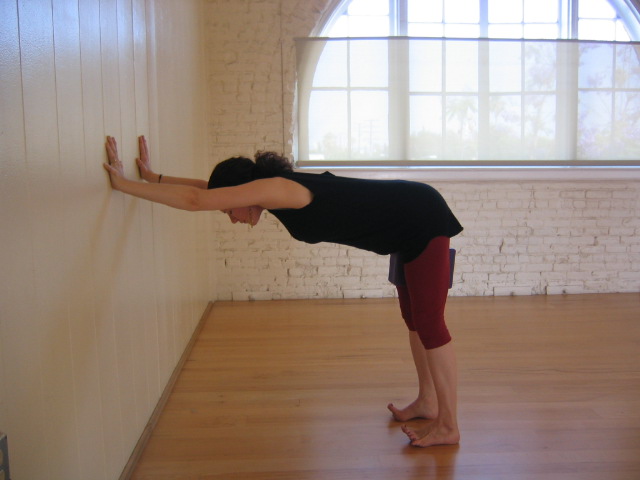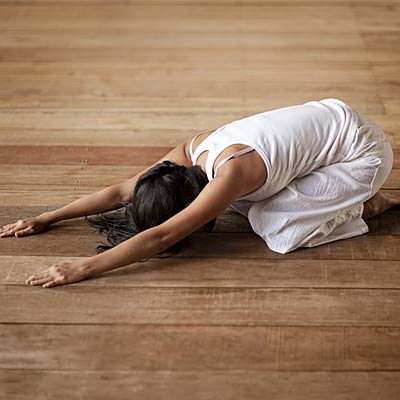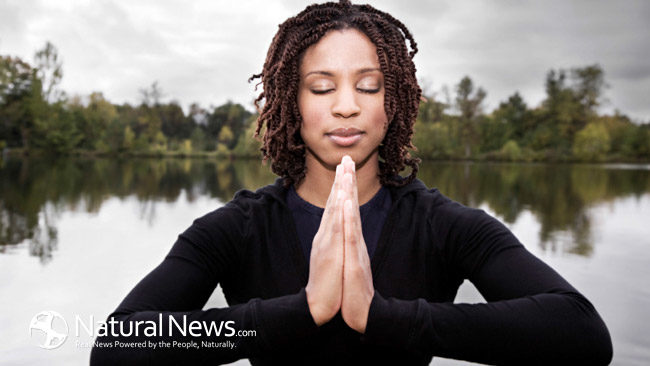Back pain is a modern epidemic that afflicts a wide cross-section of the population. Prolonged periods of stress, poor posture confounded by increasingly sedentary jobs, and the physical effects of aging can all contribute to chronic or intermittent discomfort of the spine.
The following yoga poses are easy to do, suitable for almost everyone, and they all relieve pain by alleviating compression of the joints and restoring proper blood flow.
Next time your back is a pain in the neck, try these simple solutions before reaching for the bottle of ibuprofen.
1. Forward Bend
Stand with your feet hip-width apart. Bend your knees and lower your torso over your legs until your belly touches the top of your thighs (or as close as you can without straining). Make fists and fold your arms so that each fist rests in the crease of the opposite arm’s elbow. Relax your back, neck, and head.
This pose triggers your back muscles to open. Take several slow deep breaths, allowing yourself to sink deeper into the pose with each exhale. You’ll feel your back release its tension after just a few breaths!
2. Downward-Facing Dog
This classic pose is excellent for spinal traction and maintaining lower back health.
Stand with feet hip-width apart. Bend from the waist with arms extended and your hands shoulder-width apart. Be careful not to over-arch your back, as this places most of your weight on your shoulders. Instead, think of lifting the navel and ribcage in order to keep your spine neutral. Tilt your tailbone towards your heels and press back through your legs. As you settle deeper into this pose, extend your spine and head towards the space between your hands.
Downward-Facing Dog supports proper spine alignment at the same time as it helps to open the upper chest and hips.
3. Plank (Modified for Standing)
Stand in front of a wall with your hands flat against it. Keep your fingers wide, fingertips pointing towards the ceiling.
Draw your navel back as you lengthen your tailbone towards the floor. Lift your ribs from the pelvis. The goal here is to keep your low back as neutral as possible, using your core muscles to help stabilize your posture.
Keep your spine aligned while you walk your legs back. Bend at the waist and walk your hands down the wall as you go. Eventually your body will form the shape of an ‘L’. If you feel any pain or stress in your lower back, bend your knees to maintain the proper spinal alignment.
Maintain this pose for the length of 10-15 breaths. It will help build strength in your core muscles, thereby taking some of the load off of your spine, while supporting length and flexibility in your back muscles.
4. Legs Up the Wall
 This pose can be done with or without props. If you are using a bolster or pillow, place it under your hips and lift your legs up a wall. Otherwise, lie with your tailbone as close as possible to the wall and lift your legs. Flex your toes towards your body and extend your arms out to your sides with your shoulders pulled back so that your shoulder blades are as flat against your mat as possible. Relax and breathe deep into your belly.
This pose can be done with or without props. If you are using a bolster or pillow, place it under your hips and lift your legs up a wall. Otherwise, lie with your tailbone as close as possible to the wall and lift your legs. Flex your toes towards your body and extend your arms out to your sides with your shoulders pulled back so that your shoulder blades are as flat against your mat as possible. Relax and breathe deep into your belly.
This pose releases low back pressure, elongates the spine, and develops flexibility of the leg muscles and ligaments that helps support a natural, back-healthy gait.
5. Child
 Child may be yoga’s most soothing pose. Start by kneeling with your knees a little more than hip-width apart, but with your big toes nearly touching. Bend forward from the waist so that your belly rests on the tops of your thighs and your forehead gently touches the floor. Feel free to put your fists under your forehead if you cannot comfortably reach the floor. Otherwise, extend your arms backwards alongside you with your palms facing up. Imagine that you can breathe into your back as you inhale and exhale deeply. Feel the space between each vertebra grow as you relax deeper into the pose.
Child may be yoga’s most soothing pose. Start by kneeling with your knees a little more than hip-width apart, but with your big toes nearly touching. Bend forward from the waist so that your belly rests on the tops of your thighs and your forehead gently touches the floor. Feel free to put your fists under your forehead if you cannot comfortably reach the floor. Otherwise, extend your arms backwards alongside you with your palms facing up. Imagine that you can breathe into your back as you inhale and exhale deeply. Feel the space between each vertebra grow as you relax deeper into the pose.





